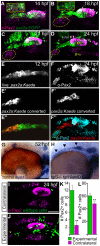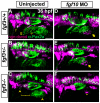Fgf3 and Fgf10a work in concert to promote maturation of the epibranchial placodes in zebrafish
- PMID: 24358375
- PMCID: PMC3866233
- DOI: 10.1371/journal.pone.0085087
Fgf3 and Fgf10a work in concert to promote maturation of the epibranchial placodes in zebrafish
Abstract
Essential cellular components of the paired sensory organs of the vertebrate head are derived from transient thickenings of embryonic ectoderm known as cranial placodes. The epibranchial (EB) placodes give rise to sensory neurons of the EB ganglia that are responsible for relaying visceral sensations form the periphery to the central nervous system. Development of EB placodes and subsequent formation of EB ganglia is a multistep process regulated by various extrinsic factors, including fibroblast growth factors (Fgfs). We discovered that two Fgf ligands, Fgf3 and Fgf10a, cooperate to promote EB placode development. Whereas EB placodes are induced in the absence of Fgf3 and Fgf10a, they fail to express placode specific markers Pax2a and Sox3. Expression analysis and mosaic rescue experiments demonstrate that Fgf3 signal is derived from the endoderm, whereas Fgf10a is emitted from the lateral line system and the otic placode. Further analyses revealed that Fgf3 and Fgf10a activities are not required for cell proliferation or survival, but are required for placodal cells to undergo neurogenesis. Based on these data, we conclude that a combined loss of these Fgf factors results in a failure of the EB placode precursors to initiate a transcriptional program needed for maturation and subsequent neurogenesis. These findings highlight the importance and complexity of reiterated Fgf signaling during cranial placode formation and subsequent sensory organ development.
Conflict of interest statement
Figures






Similar articles
-
Specification of epibranchial placodes in zebrafish.Development. 2007 Feb;134(3):611-23. doi: 10.1242/dev.02749. Development. 2007. PMID: 17215310
-
Epibranchial and otic placodes are induced by a common Fgf signal, but their subsequent development is independent.Dev Biol. 2007 Mar 15;303(2):675-86. doi: 10.1016/j.ydbio.2006.12.008. Epub 2006 Dec 9. Dev Biol. 2007. PMID: 17222818
-
Endoderm-derived Fgf3 is necessary and sufficient for inducing neurogenesis in the epibranchial placodes in zebrafish.Development. 2005 Aug;132(16):3717-30. doi: 10.1242/dev.01876. Development. 2005. PMID: 16077091
-
Early embryonic specification of vertebrate cranial placodes.Wiley Interdiscip Rev Dev Biol. 2014 Sep-Oct;3(5):349-63. doi: 10.1002/wdev.142. Epub 2014 Jul 2. Wiley Interdiscip Rev Dev Biol. 2014. PMID: 25124756 Review.
-
Making senses development of vertebrate cranial placodes.Int Rev Cell Mol Biol. 2010;283:129-234. doi: 10.1016/S1937-6448(10)83004-7. Int Rev Cell Mol Biol. 2010. PMID: 20801420 Review.
Cited by
-
How Zebrafish Can Drive the Future of Genetic-based Hearing and Balance Research.J Assoc Res Otolaryngol. 2021 Jun;22(3):215-235. doi: 10.1007/s10162-021-00798-z. Epub 2021 Apr 28. J Assoc Res Otolaryngol. 2021. PMID: 33909162 Free PMC article. Review.
-
In vitro modeling of cranial placode differentiation: Recent advances, challenges, and perspectives.Dev Biol. 2024 Feb;506:20-30. doi: 10.1016/j.ydbio.2023.11.009. Epub 2023 Dec 3. Dev Biol. 2024. PMID: 38052294 Free PMC article. Review.
-
Anteroposterior patterning of the zebrafish ear through Fgf- and Hh-dependent regulation of hmx3a expression.PLoS Genet. 2019 Apr 25;15(4):e1008051. doi: 10.1371/journal.pgen.1008051. eCollection 2019 Apr. PLoS Genet. 2019. PMID: 31022185 Free PMC article.
-
Periderm invasion contributes to epithelial formation in the teleost pharynx.Sci Rep. 2019 Jul 12;9(1):10082. doi: 10.1038/s41598-019-46040-y. Sci Rep. 2019. PMID: 31300674 Free PMC article.
-
Notch signalling regulates epibranchial placode patterning and segregation.Development. 2020 Feb 17;147(4):dev183665. doi: 10.1242/dev.183665. Development. 2020. PMID: 31988190 Free PMC article.
References
Publication types
MeSH terms
Substances
Grants and funding
LinkOut - more resources
Full Text Sources
Other Literature Sources
Molecular Biology Databases

